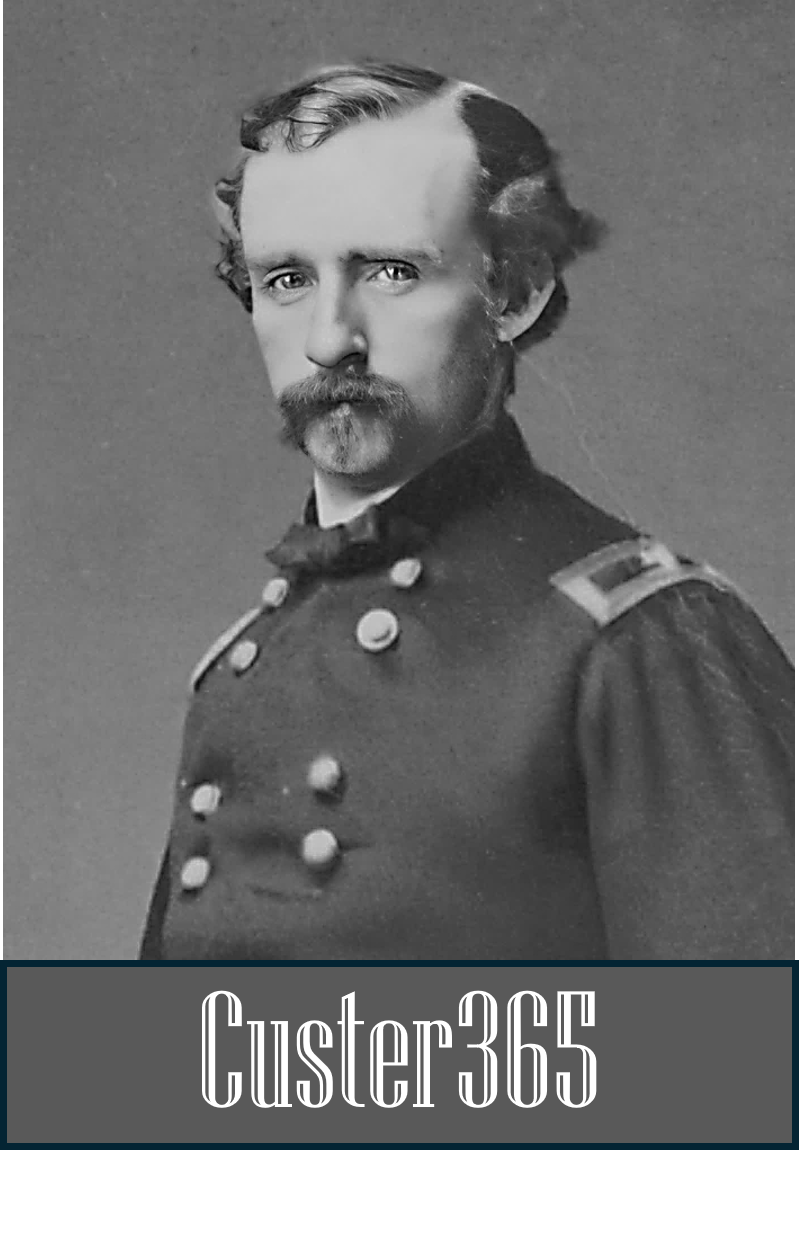BLOG ARCHIVE
George and Tom Custer get a new, little brother, Boston, born on Oct. 31, 1848.
George A. Custer dressed in costume as a Quaker Peace Commissioner in this 1875 photo. Sitting next to him is Custer’s sister, Margaret Custer Calhoun.
Not even Charlton Heston can save the Pony Express from extinction in October 1861.
George Custer’s younger brother, Nevin, names his son, born on Oct. 24, 1864, after the late military hero.
Work on the first transcontinental telegraph line, the brainchild of Western Union’s Hiram Sibley, was nearing completion this week in 1861.
Missouri Senator John Brooks Henderson leads the U.S. government in negotiations with multiple Indian tribes over the Medicine Lodge Treaty on Oct. 21-28, 1867.
The first group of European-Americans to cross the Continental Divide on Oct. 21, 1812, carry tragic news about the crew of the fur-trading ship Tonquin.
Members of Michigan’s Cavalry Brigade from the Civil War reunite for the first time in Detroit in October 1869.
On Oct. 19, 1864, Confederate soldiers led by Lt. General Jubal Early got the jump on Union troops in an early morning attack at Cedar Creek in Virginia. But a late afternoon charge by George A. Custer and Union cavalrymen turned the tide.
In our second look at movies made about George Armstrong Custer, director Raoul Walsh’s ‘They Died With Their Boots On’ came in at a hefty 2 hours, 20 minutes.
George A. Custer spent much of 1865 in the Lone Star State as the highest-ranking military officer in Texas.
After catching the play, ‘Rosedale,’ featuring actor Lawrence Barrett, in St. Louis, Libbie and George Custer head for their new Army home at Fort Riley, Kansas.
Confederate General Nathan Bedford Forrest makes it into another major motion picture, this time as the name given to a medal presented to a villainous colonel in ‘One Battle After Another.’
George A. Custer promoted a fierce fighting spirit among Michigan soldiers in the Civil War. The Detroit Historical Society offers a traveling exhibit on contributions made by the state’s fighting men.
Following his heroics at Gettysburg and promotion to Major General, Joshua Chamberlain’s pay was bumped up to $457 a month ($9,433 in 2025 dollars.) How much did other Union generals make?
Western Indian fighter and author Charles King began his career during the Civil War as an orderly for his father, Union Brig. General Rufus King. He was born on Oct. 12, 1844.
On Oct. 11, 1867, an Army court finds Lt. Col. George A. Custer guilty of absence without authorization and unlawful killing of deserters.
George Armstrong Custer is laid to rest at West Point Cemetery on Oct. 10, 1877.
Chivalry of olden days lived for a moment on Oct. 9, 1864, as Yankee George A. Custer and Rebel general Thomas Rosser saluted one another prior to initiating a battle. The fight became known as “The Woodstock Races.”
On Oct. 8, 1876, Libbie Custer pens a letter asking creators of a fund supporting widow’s of men killed at Little Bighorn to include the spouses of two officers.
Hardtack, a simple, dry cracker, was a staple food source for soldiers at posts in the West in the 1870s.
‘Custer Luck’ was the name given to George A. Custer’s uncanny streak of good fortune early in his career. Army general and military hero Winfield Scott played a role in one such episode.
Col. Wesley Merritt and troops from the 5th Cavalry Regiment arrive at Mill Creek in Colorado on Oct. 5, 1879, and rescue survivors of an earlier attack by Ute warriors.
George Custer and his wife had as many as 80 dogs with them during their marriage. One military orderly even held the job of dog keeper for the couple.
Lt. General Winfield Scott probably wouldn’t cut in in today’s U.S. Army. Learn more about this portly war hero of yore.
George A. Custer may have picked up a case of typhoid fever while serving under Union Gen. Philip Kearny in Washington, D.C., in the fall of 1861.
George A. Custer is reinstated to command of the 7th Cavalry on Sept. 30, 1868, following a year’s suspension after a court-martial conviction for leaving his troops without authorization.
Horace Greeley gets credit for saying, “Go West, young man!” in the 1860s. But, Indiana newspaper editor John B.L. Soule is believed to have first written that line on Sept. 29, 1851.
A group of Army scouts and troopers hang on for nine days for help to arrive after the Battle of Beecher Island in present-day Colorado. Cheyenne war leader Roman Nose is killed in the fighting.































